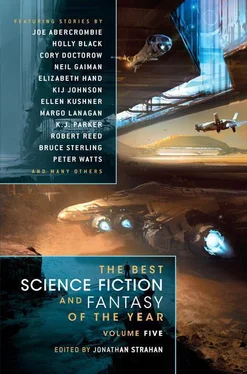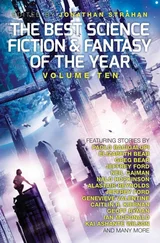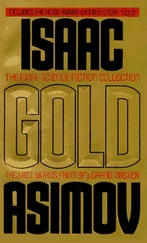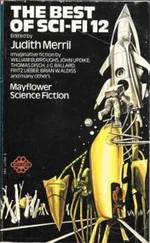Jonathan Strahan - The Best Science Fiction & Fantasy of the Year Volume 5 An anthology of stories
Здесь есть возможность читать онлайн «Jonathan Strahan - The Best Science Fiction & Fantasy of the Year Volume 5 An anthology of stories» весь текст электронной книги совершенно бесплатно (целиком полную версию без сокращений). В некоторых случаях можно слушать аудио, скачать через торрент в формате fb2 и присутствует краткое содержание. Жанр: Фэнтези, Фантастика и фэнтези, на английском языке. Описание произведения, (предисловие) а так же отзывы посетителей доступны на портале библиотеки ЛибКат.
- Название:The Best Science Fiction & Fantasy of the Year Volume 5 An anthology of stories
- Автор:
- Жанр:
- Год:неизвестен
- ISBN:нет данных
- Рейтинг книги:4 / 5. Голосов: 1
-
Избранное:Добавить в избранное
- Отзывы:
-
Ваша оценка:
- 80
- 1
- 2
- 3
- 4
- 5
The Best Science Fiction & Fantasy of the Year Volume 5 An anthology of stories: краткое содержание, описание и аннотация
Предлагаем к чтению аннотацию, описание, краткое содержание или предисловие (зависит от того, что написал сам автор книги «The Best Science Fiction & Fantasy of the Year Volume 5 An anthology of stories»). Если вы не нашли необходимую информацию о книге — напишите в комментариях, мы постараемся отыскать её.
The Best Science Fiction & Fantasy of the Year Volume 5 An anthology of stories — читать онлайн бесплатно полную книгу (весь текст) целиком
Ниже представлен текст книги, разбитый по страницам. Система сохранения места последней прочитанной страницы, позволяет с удобством читать онлайн бесплатно книгу «The Best Science Fiction & Fantasy of the Year Volume 5 An anthology of stories», без необходимости каждый раз заново искать на чём Вы остановились. Поставьте закладку, и сможете в любой момент перейти на страницу, на которой закончили чтение.
Интервал:
Закладка:
Kayaking, on Venus, did not involve water.
Carlos Fernando instructed Leah, and Epiphany helped me.
The “kayak” was a ten-meter-long gas envelope, a transparent cylinder of plastic curved into an ogive at both ends, with a tiny bubble at the bottom where the kayaker sat. One end of the kayak held a huge, gossamer-bladed propeller that turned lazily as the kayaker pedaled, while the kayaker rowed with flimsy wings, transparent and iridescent like the wings of a dragonfly.
The wings, I discovered, had complicated linkages; each one could be pulled, twisted, and lifted, allowing each wing to separately beat, rotate, and camber.
“Keep up a steady motion with the propeller,” Epiphany told me. “You’ll lose all your maneuverability if you let yourself float to a stop. You can scull with the wings to put on a burst of speed if you need to. Once you’re comfortable, use the wings to rise up or swoop down, and to maneuver. You’ll have fun.”
We were in a launching bay, a balcony protruding from the side of the city. Four of the human-powered dirigibles that they called kayaks were docked against the blister, the bulge of the cockpits neatly inserted into docking rings so that the pilots could enter the dirigible without exposure to the outside atmosphere. Looking out across the cloudscape, I could see dozens of kayaks dancing around the city like transparent squid with stubby wings, playing tag with each other and racing across the sky. So small and transparent compared to the magnificent clouds, they had been invisible until I’d known how to look.
“What about altitude?” I asked.
“You’re about neutrally buoyant,” she said. “As long as you have airspeed, you can use the wings to make fine adjustments up or down.”
“What happens if I get too low?”
“You can’t get too low. The envelope has a reservoir of methanol; as you get lower, the temperature rises and your reservoir releases vapor, so the envelope inflates. If you gain too much altitude, vapor condenses out. So you’ll find you’re regulated to stay pretty close to the altitude you’re set for, which right now is,” she checked a meter, “fifty-two kilometers above local ground level. We’re blowing west at a hundred meters per second, so local ground level will change as the terrain below varies; check your meters for altimetry.”
Looking downward, nothing was visible at all, only clouds, and below the clouds, an infinity of haze. It felt odd to think of the surface, over fifty kilometers straight down, and even odder to think that the city we were inside was speeding across that invisible landscape at hundreds of kilometers an hour. There was only the laziest feeling of motion, as the city drifted slowly through the ever-changing canyons of clouds
“Watch out for wind shear,” she said. “It can take you out of sight of the city pretty quickly, if you let it. Ride the conveyor back if you get tired.”
“The conveyor?”
“Horizontal-axis vortices. They roll from west to east, and east to west. Choose the right altitude, and they’ll take you wherever you want to go.”
Now that she’d told me, I could see the kayakers surfing the wind-shear, rising upward and skimming across the sky on invisible wheels of air.
“Have fun,” she said. She helped me into the gondola, tightened my straps, looked at the gas pressure meter, checked the purge valve on the emergency oxygen supply, and verified that the radio, backup radio, and emergency locator beacons worked.
Across the kayak launch bay, Leah and Carlos Fernando had already pushed off. Carlos was sculling his wings alternatingly with a practiced swishing motion, building up a pendulum-like oscillation from side to side. Even as I watched, his little craft rolled over until for a moment it hesitated, inverted, and then rolled completely around.
“Showing off,” Epiphany said, disdainfully. “You’re not supposed to do that. Not that anybody would dare correct him.”
She turned back to me. “Ready?” she asked.
“Ready as I’m going to be,” I said. I’d been given a complete safety briefing that explained the backup systems and the backups to the backups, but still, floating in the sky above a fifty-two-kilometer drop into the landscape of hell seemed an odd diversion.
“Go!” she said. She checked the seal on the cockpit, and then with one hand she released the docking clamp.
Freed from its mooring, the kayak sprang upward into the sky. As I’d been instructed, I banked the kayak away from the city. The roll made me feel suddenly giddy. The kayak skittered, sliding around until it was moving sideways to the air, the nose dipping down so that I was hanging against my straps. Coordinate the turn, I thought, but every slight motion I made with the wings seemed amplified drunkenly, and the kayak wove around erratically.
The radio blinked at me, and Epiphany’s voice said, “You’re doing great. Give it some airspeed.”
I wasn’t doing great; I was staring straight down at lemon-tinted haze and spinning slowly around like a falling leaf. Airspeed? I realize that I had entirely forgotten to pedal. I pedaled now, and the nose lifted. The sideways spin damped out, and as I straightened out, the wings bit into the air. “Great,” Epiphany’s voice told me. “Keep it steady.”
The gas envelope seemed too fragile to hold me, but I was flying now, suspended below a golden sky. It was far too complicated, but I realized that as long as I kept the nose level, I could keep it under control. I was still oscillating slightly—it was difficult to avoid overcontroling—but on the average, I was keeping the nose pointed where I aimed it.
Where were Leah and Carlos Fernando?
I looked around. Each of the kayaks had different markings—mine was marked with gray stripes like a tabby cat—and I tried to spot theirs.
A gaggle of kayaks was flying together, rounding the pylon of the city. As they moved around the pylon they all turned at once, flashing in the sunlight like a school of fish suddenly startled.
Suddenly I spotted them, not far above me,close to the looming wall of the city; the royal purple envelope of Carlos Fernando’s kayak and the blue and yellow stripes of Leah’s. Leah was circling in a steady climb, and Carlos Fernando was darting around her, now coming in fast and bumping envelopes, now darting away and pulling up, hovering for a moment with his nose pointed at the sky, then skewing around and sliding back downward.
Their motions looked like the courtship dance of birds.
The purple kayak banked around and swooped out and away from the city; and an instant later, Leah’s blue and yellow kayak banked and followed. They both soared upward, catching a current of air invisible to me. I could see a few of the other fliers surfing on the same updraft. I yawed my nose around to follow them, but made no progress; I was too inexperienced with the kayak to be able to guess the air currents, and the wind differential was blowing me around the city in exactly the opposite of the direction I wanted to go. I pulled out and away from the city, seeking a different wind, and for an instant I caught a glimpse of something in the clouds below me, dark and fast moving.
Then I caught the updraft. I could feel it, the wings caught the air and it felt like an invisible giant’s hand picking me up and carrying me—
Then there was a sudden noise, a stuttering and ripping, followed by a sound like a snare drum. My left wing and propeller ripped away,the fragments spraying into the sky. My little craft banked hard to the left. My radio came to life, but I couldn’t hear anything as the cabin disintegrated around me. I was falling.
Falling.
For a moment I felt like I was back in zero-gee. I clutched uselessly to the remains of the control surfaces, connected by loose cords to fluttering pieces of debris. Pieces of my canopy floated away and were caught by the wind and spun upward and out of sight. The atmosphere rushed in, and my eyes started to burn. I made the mistake of taking a breath, and the effect was like getting kicked in the head. Flickering purple dots, the colors of a bruise, closed in from all directions. My vision narrowed to a single bright tunnel. The air was liquid fire in my lungs. I reached around, desperately, trying to remember the emergency instructions before I blacked out, and my hands found the emergency air-mask between my legs. I was still strapped into my seat, although the seat was no longer attached to a vehicle, and I slapped the breathing mask against my face and sucked hard to start the airflow from the emergency oxygen. I was lucky; the oxygen cylinder was still attached to the bottom of the seat, as the seat, with me in it, tumbled through the sky. Through blurred eyes, I could see the city spinning above me. I tried to think of what the emergency procedure could be and what I should do next, but I could only think of what had gone wrong. What had I done? For the life of me I couldn’t think of anything that I could have done that would have ripped the craft apart.
Читать дальшеИнтервал:
Закладка:
Похожие книги на «The Best Science Fiction & Fantasy of the Year Volume 5 An anthology of stories»
Представляем Вашему вниманию похожие книги на «The Best Science Fiction & Fantasy of the Year Volume 5 An anthology of stories» списком для выбора. Мы отобрали схожую по названию и смыслу литературу в надежде предоставить читателям больше вариантов отыскать новые, интересные, ещё непрочитанные произведения.
Обсуждение, отзывы о книге «The Best Science Fiction & Fantasy of the Year Volume 5 An anthology of stories» и просто собственные мнения читателей. Оставьте ваши комментарии, напишите, что Вы думаете о произведении, его смысле или главных героях. Укажите что конкретно понравилось, а что нет, и почему Вы так считаете.












